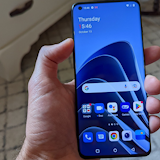
The Nokia Lumia 610 is the affordable compatriot of the current Nokia flagship: the Nokia Lumia 900. The Lumia 610 has taken to its budget-smartphone label with some pretty serious aplomb, boasting heavily toned-down hardware and specs in order to keep costs low. The real question is whether or not this Windows Phone 7.5 powered device suffers from its lack of impressive internals. To find out read on as we continue our Nokia Lumia 610 review.
Physical Design of the Nokia Lumia 610
For a budget device, the Lumia 610 is actually quite handsome. Available in blue, pink, white and black, the external design seems to have had a lot more thought put in to it than similarly-priced handsets from other manufacturers.
While we’re not usually fans of a big, shiny chrome edge, it actually suits the Lumia 610. This is probably because the various colors each sport their own matching chrome border, rather than just relying on a stock-standard silver option.
The overall shape isn’t overly sleek but it still has a kind of streamlined quality to it, giving it at least the appearance of being thinner than it really is. Ultimately we had to say that we enjoyed the look of the Lumia 610 even more than some of the more expensive smartphones coming out these days, even if it’s still nothing compared to the top-end competitors.
As far as comfort goes the Lumia 610 was definitely manageable when kept in the pocket and its surprising weight gave it a reassuring feel when held in the hand. The curved back made it easy to hold and the glossy finish didn’t detract too much from grip.
Our only complaint was that it felt a bit small after using the larger devices coming out today. At 62x119x12mm with just a 3.7 inch display the Lumia 610 is definitely on the diminutive side of the smartphone market. However, a smaller smartphone might definitely appeal to some and, of course, the 610 is pretty similar in overall size to the iPhone 4S, so it’s either a positive or a negative depending on who’s doing the judging.
 Display and UI
Display and UI
The 3.7 inch display of the Lumia 610 is passable, but no more than one might expect from a device in its price range. With a resolution of 480x800 (the same as any high-end Windows Phone 7 handset), the 610 certainly delivers crisp images, but with noticeably washed-out colors. We also found viewing angles to be extremely poor to the point where often the top or bottom of the screen became slightly fuzzy when we were actually holding and using the device. This wasn’t so bad that we were unable to see what we were doing, but there was some definite discoloration at times.
The Windows Phone 7.5 UI was, as always, gorgeous. Of course with Windows Phone 8 and 7.8 both having been demonstrated WP7 is beginning to look a little dated, but we still like it. Unfortunately the Lumia 610’s lack of color vibrancy did cause the UI’s aesthetic appeal to suffer a little, but that’s often the price of sacrificing hardware in favor of being frugal.
The 800MHz CPU backed up by just 256MB of RAM did feel much slower than the likes of the Lumia 900 and 800, both of which we found to be smooth, fluid devices. By contrast, the Lumia 610 often lagged in between screens or when opening & closing apps.
In short, the Lumia 610 still had everything we loved about the Windows Phone 7 UI, but delivered it with less aplomb than its higher-end cousins.
 Camera and Battery Life
Camera and Battery Life
The 5MP camera of the Lumia 610 was, once again, passable for its price-range. As always we loved the camera integration and the dedicated camera button on the side of the device. The 610 was very easy to simply point at whatever we wanted and take a well-framed shot.
As far as image clarity goes there was certainly a fall-off from what we’re used to, but not too much can be expected from budget smartphone with 5MP shooter.
Folk who are after a great camera experience should definitely look elsewhere, but many users should find the Lumia 610’s photo quality acceptable.
Battery life was great; almost a day and a half at medium to heavy use. Obviously that meant we still had to charge it every night, but we never once found ourselves running for an outlet, or even in danger of doing so. This is one of the benefits of trimming down hardware to save on cost; the less fancy gizmos whirling around in a device the less the power requirements will be.
 Browsing and Keyboard
Browsing and Keyboard
The browser wasn’t exceptionally fast, but tended to not suffer from the same level of lag problems found in other areas of the device. The standard local-search results that we love from the WP7 IE browser were still there, as was the classy layout.
Pages tended to load quickly and images didn’t slow things down too much. We did find the 3.7 inch screen a little cramped when it came to reading articles or emails, but once again that’s a personal preference thing. iPhone users shouldn’t find this to be concerning at all, but anyone used to a bigger display should be warned. Once you get used to that extra screen real-estate it’s very difficult to go back.
The same applies for keyboards. The Lumia 610’s onscreen keypad was fast and responsive, but again lacked the seamless ease we experience with larger variants. Our fat fingers struggles to maintain the mixture of accuracy and speed that we’ve become used to when held in portrait mode. Landscape was certainly manageable, but we still felt the creeping press of display claustrophobia. Users who are used to smaller screens, or who have more petite digits than us shouldn’t worry, but anyone for whom our story sounds familiar should heed our warning.
 The WhistleOut Opinion
The WhistleOut Opinion
It may sound like we’ve been unimpressed by the Nokia Lumia 610 but that’s not really true. The 610 simply has the unfortunate privilege of being a low-cost, low-spec smartphone in an increasingly impressive market. However, as far as smartphones at the lower-end of the market go we were actually pleasantly surprised with this one.
Usually budget phones have one or two glaring faults that, after a time, become agonisingly frustrating. App crashes, inability to download new apps and a plethora of other issues crop up all the time. This was simply not so with the Lumia 610.
Yes, it was slow and sometimes lagged. Yes, the screen wasn’t the greatest. But the combination of Nokia’s unique style and the relatively un-demanding nature of the Windows Phone 7.5 OS managed to offer a passable smartphone at an extremely reasonable price.
Anyone looking for a cheap way of entering or staying in the world of smartphone communication should definitely give the Lumia 610 a go. Where cheap Androids often run on out-dated versions (meaning many apps will not run), the closed nature of Windows Phone has allowed the 610 to keep up with its contemporaries in terms of software compatibility. In short it’s a reliable little device that does no more or no less than what should be expected of it.
A word of caution to finish this tale: the Lumia 610, like every other Windows Phone 7 device, will not see the upcoming Windows Phone 8 update. There’s a good chance that the mainly-aesthetic Windows Phone 7.8 update could make an appearance, but the current generation of WP7 smartphones are simply not powerful enough to make the WP8 jump. Normally this would mean we would warn against buying this device at all, but with its super-low cost (compared to other smartphones) we don’t see the harm. It will still be a functional and reliable piece of equipment for what you pay, so long as you keep in mind that you won’t be seeing any Windows Phone 8 goodies.



Related Articles
Related Topics
Nokia Windows Phone 7 Windows Phone Windows Phone Mango Review Nokia Lumia Nokia Lumia 610Popular Topics
Android Apple iPhone Samsung Google iOS Cell phone plans Rogers Telus BellFind Better Phones and Plans
Hundreds of cell phone plans unpacked. All the facts. No surprises.




































